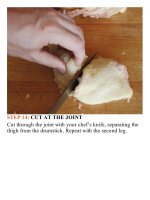The food lab better home cooking through science ( PDFDrive ) 123
Bạn đang xem bản rút gọn của tài liệu. Xem và tải ngay bản đầy đủ của tài liệu tại đây (131.62 KB, 2 trang )
CLARIFIEDBUTTER
S
olid butter maylook like a single, homogeneous
substance, but melt it in a pan, and it quickly
becomes apparent that it’s made up of a few
differentthings.
• Butterfat makes up around 80 percent of the
weightofbutter(upto84percentforsomehighend “European-style” butters, or as low as 65
percent for some fresh-churned, farm stand–
style butters). Because there are many different
fats that make up butterfat, each one of which
softens and melts at a specific temperature
range, butter goes through many textural
changes as you heat it, slowly softening and
becomingmoreandmoremalleableuntilfinally,
ataround95°F,allofthefatsareliquefied.
•Watermakesupanother15percent(downto11
percent for high-end butters, up to 30 percent
for fresh-churned butters). In the cool environs
of the fridge, the water and fat in a stick of
butter commingle without any problem. But
apply some energy to the situation by heating it
inaskillet,andeventuallythewaterconvertsto
steam, forming small bubbles of vapor and
causing your butter to foam. Once the foaming
hassubsided,youknowthatallofthewaterhas
made its escape andyour butter has begun to
climb above 212°F. Since water is denser than
fat, when butter is melted in a large pot, this
layerofwater(andafewdissolvedproteins)will
sinktothebottom,whereitwillbegintobubble
ifheatedlongenough.
• Milk proteins, mainly casein, make up the
remaining5percent(orso)ofthebutter.These
proteins are the milky white scum that floats to
the top of your butter as you melt it, and it’s
these proteins that will begin to brown and
eventuallyburnandsmokeasyouheatbutterin
ahotskillet.
Because of its water and protein content, plain









